| PUBLISHER |
XTREME PROTOTYPES |
|
HOMEPAGE |
|
|
DELIVERY |
DIRECT DOWNLOAD + REGISTRATION
KEY UPON PURCHASE
|
|
DOWNLOAD FILE SIZE |
89 MB |
|
DOWNLOAD MANUAL SAMPLE |
X-15-2-3_manual_eng_DEMO_01.pdf
|
|
SUPPORT |
|
|
VERSION |
FSX FS2004 |
BUNDLE OFFER
Purchase 2 packages and save 20%
Purchase all 3 packages and save 30%
This package contains 2
versions of the X-15-2 and two versions of the X-15-3 aircraft, all equipped
with the mighty XLR-99 rocket engine.
The X-15-2
(serial number AF56-6671) became the first X-15 aircraft to test the
million-horsepower XLR-99 rocket engine in flight. The X-15-2 was delivered to
Edwards Air Force Base in April 1959 and completed 31 flights (9 with the
interim XLR-11 engines) before it was damaged during an emergency landing in
November 1962, and eventually repaired and modified to become the "advanced"
X-15A-2.
The X-15-3
(serial number AF56-6672) was delivered to Edwards in the summer of 1959. The
aircraft was seriously damaged in June 1960 when its ammonia and hydrogen
peroxide tanks exploded while testing the new XLR-99 engine on the ground. Pilot
Scott Crossfield was uninjured and the aircraft was rebuilt.
In August
1963, NASA pilot Joe Walker set an altitude record of 354,200 feet in the No. 3
aircraft, the highest flight of the X-15 research program.
The X-15-3
completed 65 flights between December 1961 and November 1967. Sadly, the
airplane was lost during a tragic accident in November 1967 that took the life
of Air Force pilot Michael Adams.
X-15-2/3 for
Flight Simulator Key Features
- Custom X-15 flight model
to simulate rocket-powered high-speed and high-altitude flight in FS2004 and
FSX:
- Supersonic flight up to
Mach 4.65 in FS2004 and FSX
- High-altitude flight up
to 354,200 feet in FSX (100,000 feet in FS2004)
- Can be launched either
from a high altitude like the real X-15 or take off from an airport runway
like other Flight Simulator aircraft
- Good maneuvrability at
supersonic speeds and excellent gliding capabilities
- Highly detailed 3D models
with more than 300 parts, 60 animations, reflective textures and unique
markings, based on archive material
- Fully functional
instrument panels with 200 custom gauges and systems to simulate almost every
step and procedure required in a typical X-15 mission
- Spectacular visual
effects including rocket engine flames, APU exhaust and propellant jettison
effects
- Uses a custom fuel
management system with three different types of propellants (ammonia, liquid
oxygen and hydrogen peroxide) and pressurized helium, like in the real-world
X-15 rocket plane
- Includes a comprehensive
100-page user manual inspired from the original X-15 utility flight manuals,
in a printable PDF format (English and French language versions are included
with the software)
X-15-2/3 Add-on Aircraft
Description
This package contains two
versions of the X-15-2 aircraft (serial number AF56-6671) with the XLR-99 rocket
engine and two versions of the X-15-3 aircraft (serial number AF56-6672) with
the XLR-99 rocket engine.
This is the design-mission
configuration of the No. 2 X-15 rocket plane. The second variation of the X-15-2
wears gray thermopaint on the canopy, the nose and other parts of the aircraft.
The No. 3 X-15 airplane was
equipped with the new MH-96 adaptive flight control system which replaced the
stability augmentation system (SAS) found in the other aircraft.
The second variation of the
X-15-3 has removable wing-tip pods that contained cameras and research
instruments. This aircraft has a revised blue-gray instrument panel that
replaced the original black panel. The new panel contrasted better with the
gauges, light indicators and flight instruments. The airplane also features a
tail-cone box with additional experimentation equipment.
|

"Dirty" version of the X-15-2 with the (interim) NACA vane-type boom nose
and the original (XLR-99) black panel; |

"Dirty" version of the X-15-2 with the NACA/Nortronics ball nose, gray
thermopaint on nose and canopy, and an alternate (XLR-99) black panel. |
|

"Dirty" version of the X-15-3 with the NACA/Nortronics ball nose and the
original (XLR-99) black panel; |

"Dirty" version of the X-15-3 with the NACA/Nortronics ball nose, wing-tip
pods, tail-cone box and the (XLR-99) light blue-gray panel. |
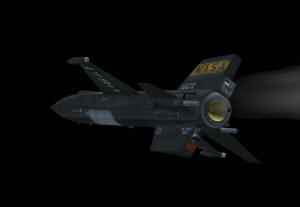 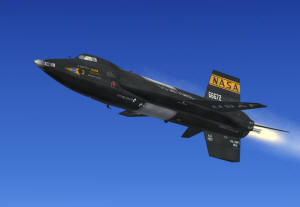
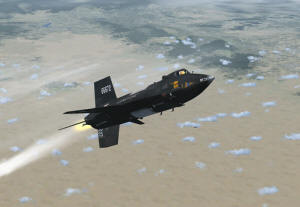 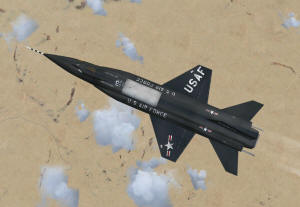
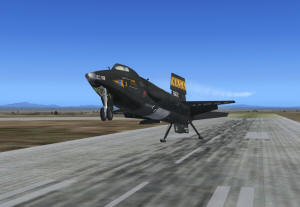 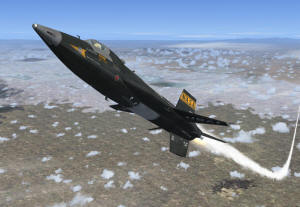
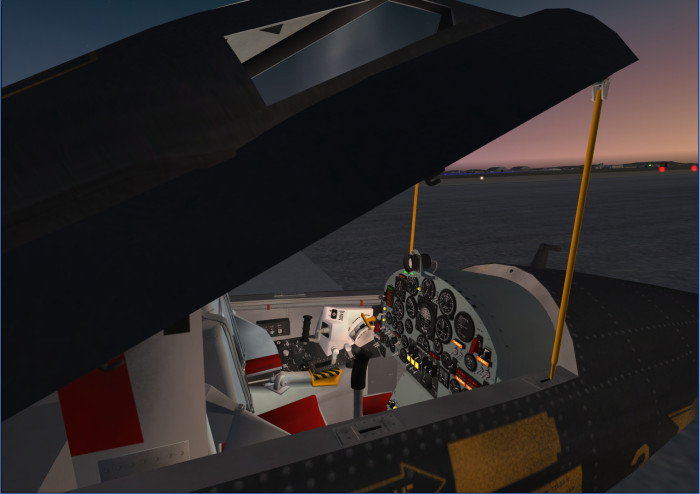
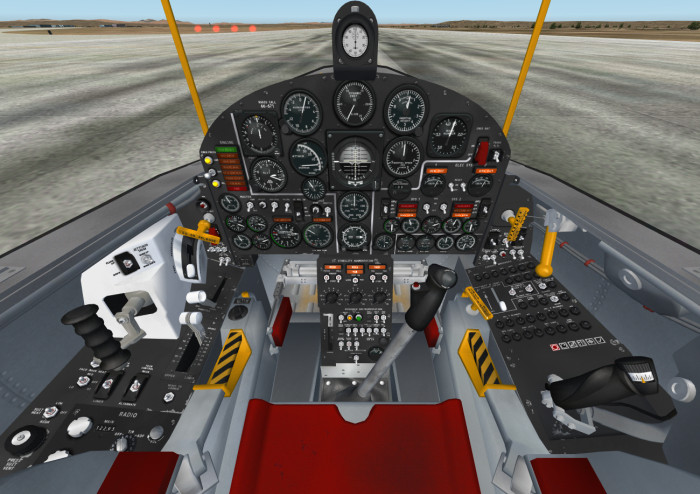
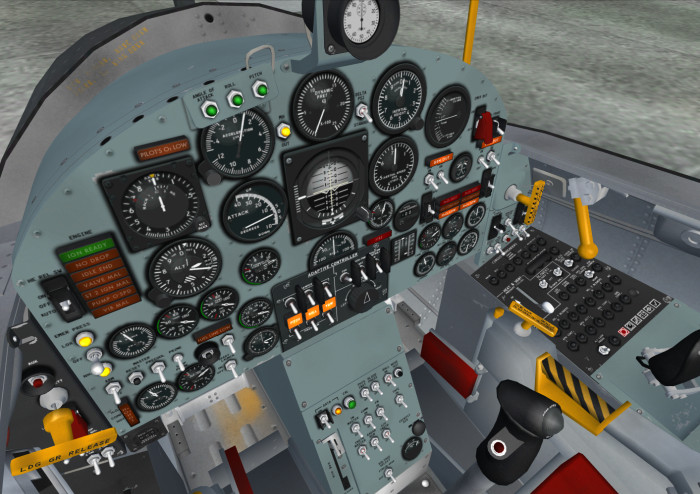
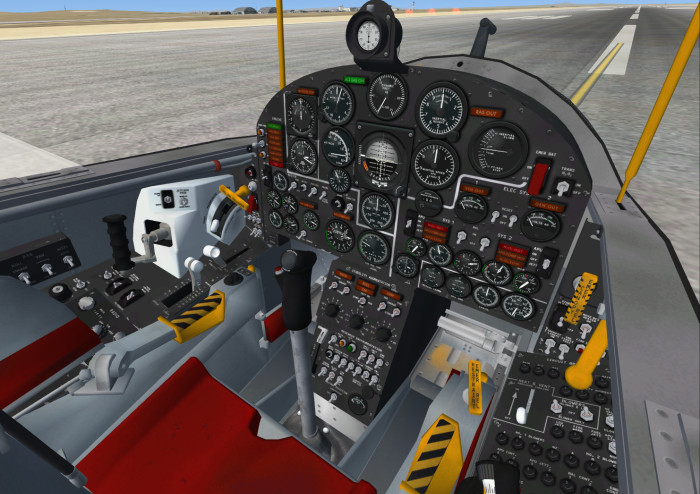
NEW!
Each of the X-15-2 and X-15-3 aircraft come with their own 3D fully functional
virtual cockpits which contain over 900 parts and nearly 200 animated gauges,
switches, levers, light indicators and flight instruments.
| The VC
allows a total 3D immersion into the X-15 flying environment and comes with
new internal spotlights, switches, control sticks, handles and levers with
tooltips. Virtually all switches in the VC are clickable and can be used to
simulate nearly every procedure required during a mission. |
As with the 2D instrument panels and the exterior models, each virtual
cockpit has been meticulously created to conform as closely as possible to the
cabin of the real X-15 rocket aircraft.
NEW!
Automatic Ignition Sequence – The X-15 can now be started
automatically at the touch of a single "magic" red button. This is similar to
pressing CTRL+E with conventional FS aircraft. However, the red button initiates
all X-15 internal custom systems, including her three-propellant rocket fuel
management system.
X-15-2/3 Advanced Instrument
Panels
What makes the
X-15 for Flight Simulator series exciting and unique are the advanced fully
functional instrument panels with custom gauges and systems to simulate almost
every step and procedure required in a typical X-15 mission:
- Aircraft servicing (all
three propellants and gases);
- APUs/generators/hydraulic
pump operation;
- Propellant tank
pressurization;
- Engine precool and prime;
- Turbopump operation;
- Rocket ignition sequence;
- Monitoring of propellant
pressure gauges;
- Propellant jettison.
Almost every X-15 internal
system has been integrated into the X-15 for Flight Simulator panels:
- Engine propellant and
control system;
- Engine ignition system;
- APUs and electrical power
distribution systems;
- Hydraulic systems;
- Temperature control systems.
The X-15-2/3
for Flight Simulator comes with four main instrument panels and eight secondary
panels, either in their original black version or the later light blue-gray
version. Included with each X-15-2 or X-15-3 add-on aircraft is:
- A main panel;
- A service panel;
- A "vent, pressurize,
jettison" lever panel;
- A throttle and speed brake
lever panel;
- A left side panel;
- A right side panel;
- A radio panel (ADF panel on
some aircraft);
- A center pedestal panel with
research instrumentation and stability augmentation system (SAS, or MH-96
system on the X-15-3) panels;
- An RAS (reaction
augmentation system) panel on one of the X-15-2 aircraft.
In addition,
the default Flight Simulator Garmin GPS and magnetic compass panels are
available from the main panel. Note that one variation of the X-15-3 has a
revised light blue-gray instrument panel that replaced the original black panel.
The new panel contrasted better with the gauges, light indicators and flight
instruments.
|
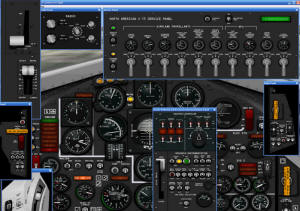
X-15-3 (XLR-99 engine) instrument panels.
Note the service panel at the top and the MH-96 adaptive flight control
system panel on the center pedestal. |
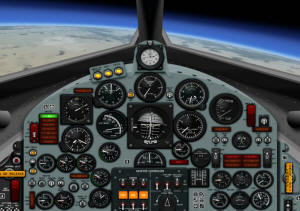
X-15-3 (XLR-99 engine) revised light
blue-gray main instrument panel during flight. Note the MH-96 system control
panel in the lower center section of the main panel. |
|
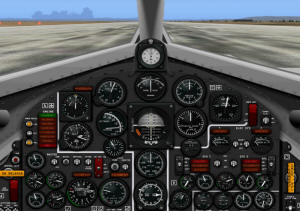
X-15-2 (XLR-99 engine) main instrument panel.
Note the square machmeter at right and the unusual position of the helium
release selector switch in the left section of the panel. |
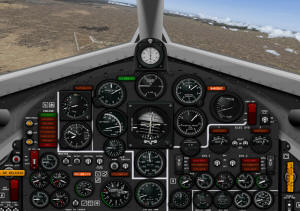
Alternate version of the X-15-2 (XLR-99
engine) main instrument panel during a final approach for landing at Edwards
Air Force Base. Note the engine timer at the top. |
X-15-1 Utility Flight Manual
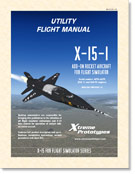 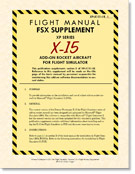
Included with the software are
the 100-page English and French versions of the X-15-2/3 Utility Flight Manual,
available in a printable PDF format (Adobe® Acrobat® Reader 5.0 or later
required).
The manual has been
specifically conceived for the X-15-2/3 for Flight Simulator and is based on the
original real-world X-15 utility flight manuals.
The flight manual contains the
necessary information for the installation and operation of the X-15-2 and
X-15-3 virtual aircraft and associated instrument panels. It contains
instructions and procedures for XLR-99 rocket engine operation, on the X-15-2/3
for Flight Simulator.
The end-user is encouraged to
print a copy of the manual for his/her own use, in conjunction with the add-on
simulation software. The best way to keep the manual handy for easy reference
during flight is to organize it in a durable presentation binder.
.
Product Specifications
(X-15-2/3 for Flight Simulator)
MINIMUM SYSTEM REQUIREMENTS
- Flight Simulator: Microsoft®
FS2004, FSX (optimized for FS2004, FSX compatible)
- Windows®: 2000/XP (128 MB
RAM)
- Processor: 450 MHz
- Hard Drive: 1.8 GB
- Available Disk Space: 200 MB
(space required to install the add-on software and documentation)
- Video Card: 32 MB (DirectX®
9.0 or later)
- Other: Sound card and
speakers, joystick, Adobe® Acrobat® Reader 5.0 or later
GENERAL FEATURES 2
versions of the X-15-2 aircraft (s/n AF56-6671) with the XLR-99 rocket engine:
- "Dirty" version with the
(interim) NACA vane-type boom nose and the original (XLR-99) black panel;
- "Dirty" version with the
NACA/Nortronics ball nose, gray thermopaint on nose and canopy, and an
alternate (XLR-99) black panel.
2 versions of the X-15-3
aircraft (s/n AF56-6672) with the XLR-99 rocket engine:
- "Dirty" version with the
NACA/Nortronics ball nose and the original (XLR-99) black panel;
- "Dirty" version with the
NACA/Nortronics ball nose, wing-tip pods, tail-cone box and the (XLR-99) light
blue-gray panel.
FLIGHT MODEL FEATURES
- Custom X-15 flight model to
simulate rocket-powered high-speed and high-altitude flight in FS2004 and FSX
- One Reaction Motors XLR-99,
"throttable" 60,000-pound liquid-fuel turbo-rocket engine
- Supersonic flight up to Mach
4.65 in FS2004 and FSX
- High-altitude flight up to
354,200 feet in FSX (100,000 feet in FS2004)
- Ground takeoff or
high-altitude launch
- Good maneuvrability at
supersonic speeds
- Excellent gliding
capabilities
AIRCRAFT 3D MODEL FEATURES
- Highly detailed models based
on archive material, with more than 300 parts and 60 animations
- Reflective textures
- Unique markings and liveries
(on each aircraft)
- Dynamic frost texture on
fuselage (around the liquid oxygen tank when filled)
- Movable aerodynamic control
surfaces:
- Differential horizontal
stabilizer
- Vertical stabilizers with
movable and fixed sections and a jettisonable ventral rudder
- Flaps
- Extendable upper and lower
split-flap speed brakes
- Landing skids and front gear
("steerable")
- Movable canopy
- Cockpit details with
astronaut/pilot and animated sticks and levers
- Experimental equipment on
some airplanes (wing-tip pods, tail-cone box, etc.)
SPECIAL VISUAL EFFECTS
- Over 10 X-15-specific
animated visual effects
- Engine flame and contrail
effects
- Engine first and/or second
stage igniter effects
- Propellant jettison effects
- APU and turbopump exhaust
effects
- Engine precool and prime
effects
- Condensation effect near the
cold propellant tanks when filled
CUSTOM AIRCRAFT SYSTEMS
FEATURES
- Fictional service panel
system for external power and aircraft refueling (ammonia, liquid oxygen,
hydrogen peroxide, helium, liquid nitrogen)
- Custom X-15 fuel management
system for the three different types of propellants and gases, like in the
real-world X-15 rocket plane
- Engine propellant
pressurization and control system
- Engine turbopump system
- Engine ignition control
system
- Electrical distribution and
control system with APUs, generators, emergency battery and an external power
source
- Hydraulic systems
- Temperature control systems
ADVANCED 2D PANEL FEATURES
- Advanced X-15 black (2D)
main instrument panels (XLR-99 engine)
- Advanced X-15 light
blue-gray (2D) main instrument panel (XLR-99 engine)
- Service panel
- Left white console panel
with "vent, pressurize, jettison" lever and flaps switch
- Throttle and speed brake
panel
- Left side panel
- Right side panel
- Radio panel (ADF panel on
some aircraft)
- RAS panel (on some aircraft)
- Center pedestal with
research instrumentation and stability augmentation system panels (or MH-96
system panel on the X-15-3)
- 200 fully functional custom
integrated systems and gauges with "tooltips"
- X-15-2 and X-15-3 aircraft
kneeboard reference tabs and check lists
- 100-page English and French
language utility flight manuals with step-by-step procedures (PDF formal,
requires Adobe® Acrobat® Reader)
| Available Options: |
| Delivery: |
|
|

